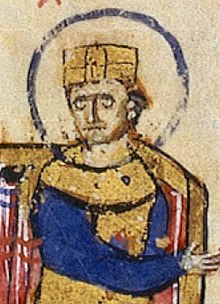
Back Leo V die Armeen Afrikaans Leo V. (Byzanz) ALS León V l'Armenio AN ليون الخامس الأرمني Arabic ليون الخامس الارمنى ARZ V Leo (imperator) Azerbaijani بئشینجی لئوی AZB Лъв V Арменец Bulgarian Leon V Armenac BS Lleó V l'Armeni Catalan
| Leo V the Armenian | |
|---|---|
| Emperor of the Romans | |
 Depiction of Leo from the 12th century Madrid Skylitzes. | |
| Byzantine emperor | |
| Reign | 12 July 813 – 25 December 820 |
| Coronation | 12 July 813[1] |
| Predecessor | Michael I |
| Successor | Michael II |
| Co-emperor | Constantine |
| Born | c. 775 |
| Died | 25 December 820 (aged c. 45) |
| Consort | Theodosia |
| Issue | Constantine Basil Gregory Theodosios Anna |
| Father | Bardas |
Leo V the Armenian (Greek: Λέων ὁ Ἀρμένιος, Leōn ho Armenios; c. 775 – 25 December 820) was the Byzantine emperor from 813 to 820. He is chiefly remembered for ending the decade-long war with the Bulgars, as well as initiating the second period of Byzantine iconoclasm.
A senior general of Armenian origin, Leo distinguished himself under Nikephoros I and Michael I Rhangabe, eventually becoming the stratēgos of the Anatolic Theme. Taking advantage of Michael's defeat at the Battle of Versinikia, he forced the emperor to abdicate in his favour. He was able to withhold the blockade of Constantinople by Krum of Bulgaria and, after Krum's death, concluded a 30-year peace with his successor Omurtag.
In 815, Leo deposed Patriarch Nikephoros and reinstituted iconoclasm. He was assassinated by supporters of Michael the Amorian, one of his most trusted generals, who succeeded him on the throne in 820.
- ^ Mango, Cyril A., ed. (1997). "A.M. 6305". The Chronicle of Theophanes Confessor. Oxford University Press. p. 502. ISBN 9780198225683.